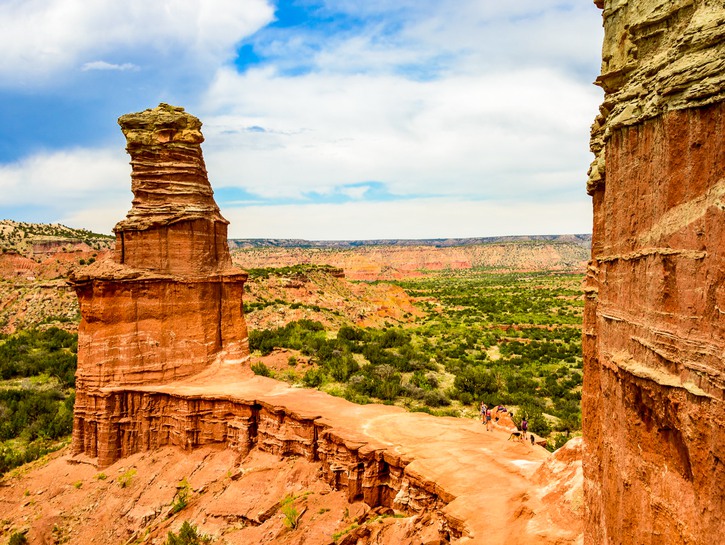
You know how the song goes: “The stars at night, are big and bright…”
Videos by TravelAwaits
Nowhere is that truer than at Palo Duro Canyon State Park in the heart of the Texas Panhandle. If you’ve never heard of it, you’re not alone; it’s not nearly as famous as it deserves to be. Nevertheless, it’s the second largest canyon in the United States – after the Grand Canyon. Of course, it’s impossible to compare the two, but Palo Duro does offer some advantages you won’t find anywhere else.
Size
It’s difficult being the second in anything: families, the Olympics, and – yes! – canyons.
Palo Duro Canyon is 120 miles long, over 800 feet deep, and 6 miles wide on average (but up to 20 miles wide at points). Compare that to the Grand Canyon which is 277 miles long, more than 5000 feet deep, and 18 miles from rim to rim. The Grand Canyon is jaw-dropping, but it almost looks like a painting when you’re standing on the edge of it.
Palo Duro Canyon, on the other hand, feels real. It’s beautiful and approachable, not so intimidating that you question how to tackle the adventure before you do.

Access
Palo Duro Canyon is about 30 minutes south of Amarillo, Texas. Once you’ve seen Cadillac Ranch and taken the 72oz Steak Challenge at The Big Texan in Amarillo, you’ll need a good, long walk.
But that may be one of the best parts about Palo Duro: you don’t need a mule, helicopter, or an all-day hike to get to the canyon floor. You don’t have to walk at all if you don’t want to. After paying the $5 per person fee to get in, you can drive down to the canyon floor, follow the road through the park, and drive right back out. There will be places you’ll want to stop, but it can be as quick a visit as you want to make it.

Experiences
Perhaps the biggest draw at Palo Duro is the beautiful system of trails, and the cathedral of canyon walls that surround it. You can walk, bike, even ride a horse through the canyon. (If you don’t have one of your own, Old West Stables will take you on a one-hour guided tour.)
No matter how you experience Palo Duro, you have to see the park’s iconic hoodoo known as The Lighthouse. Hoodoos are slender rock formations with a larger rock on top. You’ll only be able to see it from the canyon floor if you take the Lighthouse Trail, which is about 5.5 miles round trip. You can also get a look at it via the telescope at the Visitor’s Center.
The wonderful thing about any hike at Palo Duro is that you can go as far as you like, and turn around whenever you want. But you should spend the night if you really want to experience the peacefulness of the canyon; the expansive palette stars is worth staying for. There are campsites for RVs, campers, and tents to accommodate you. There are also four cabins on the canyon floor and three more on the rim. You can reserve your spot at the campsites or in the cabins online.
For more than 50 years, thousands have flocked to the canyon floor in the summer to enjoy performances of the musical drama TEXAS. The show takes place at the Pioneer Amphitheater Tuesday-Sunday starting at 8:30 p.m., and portrays the history of the people who settled the Texas Panhandle. There’s singing, dancing, Texas humor, and even fireworks at the end! You can visit backstage before the performance if you arrive before 7:15 p.m. If you care to come hungry, you can eat dinner in the canyon before the show for an additional cost. The producers recommend you get your tickets at least two weeks in advance.

Nature
The many-colored stone walls retell the 250 million year story of the canyon. Palo Duro was formed by the Prairie Dog Town Fork of the Red River, leaving behind four distinct geologic layers. There are wildflowers, grasses, yucca, and prickly pear cacti, as well as plenty of juniper, mesquite, and cottonwood trees on the canyon floor.
The canyon is also home to its share of wildlife. You may see snakes (some venomous), lizards, wild turkeys, coyotes, roadrunners, bobcats, deer, and several types of birds – including woodpeckers. The fauna may not entice you to come. But if you made it past ‘snakes’, knowing that the largest population of Palo Duro mice is also found here probably won’t bother you. This type of mouse is only found in three counties in Texas. Consider it a warning, consider it a reason to visit – it’s up to you.
You do need to be prepared when hiking, biking, or horseback riding on the trails, not just for the critters you might encounter, but for the heat as well. The weather varies greatly in the canyon throughout the year. There are signs at the trailheads which warn of the dangers of heat and urge everyone to carry at least a gallon of water per person (and pet). Hats, sunscreen, and anything else that could protect you from the sun are also a must. Thermometers in the park show the temperature the keep you apprised of the possibility of heat stroke. The park takes the safety of its visitors seriously, and those who work here want to make sure the beauty of the area doesn’t cause you to let your guard down.

History
People have lived in the canyon for about 12,000 years. The earliest hunted mammoth and giant bison; archeologists have found tools, paintings, and other relics here.
It’s believed that early Spanish Explorers found the canyon and named it Palo Duro, which is Spanish for “hard wood,” because of the trees they found when they arrived. Native Americans called the canyon home until they were forced out in 1874. A few years later, JA Ranch began in the canyon with more than 1,500 head of Longhorn cattle.
Eventually, the State of Texas bought the upper section of the canyon which became Palo Duro Canyon State Park.
Photo Credit: Zack Frank / Shutterstock
Photo Credit: Daniel R Humphries / Shutterstock
